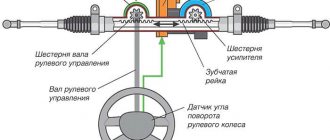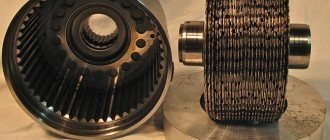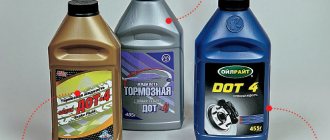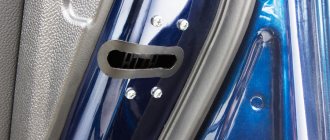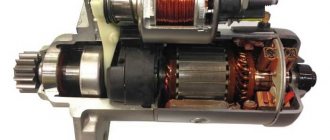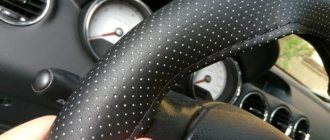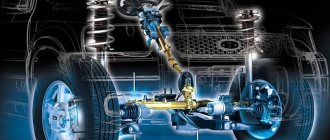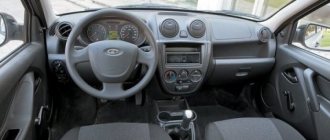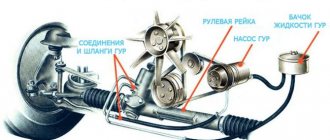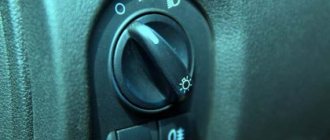- home
- Car suspension
- …
Electric power steering, or simply EPS, replaces its common opponent, namely the hydraulic power steering (power steering). This is facilitated by the development of technology, the development of electronics, as well as the installation of advanced driver assistance systems (for example, automatic parking). Also, its electric counterpart allows you to save a little fuel. Now there are at least 4 main designs of this type. BUT! Many manufacturers are in no hurry to switch from “hydro” to “electric”. But why? Is it as ideal as it works? How does the EUR work? How should it be operated so as not to be ruined? We’ll talk to you about this today, as usual there will be a video version. So let's read and watch...
First, a little definition.
EPS (electric power steering) is an electromechanical system that allows you to reduce the control force applied to the steering wheel.
At the very beginning, I would like to say that this article will not be about comparing power steering and power steering ; I already have such an article (although some points will still slip through).
About EGUR
Another useful information and again at the beginning of the article, many people confuse the electric power steering with the so-called electric power steering - electric power steering. But this is extremely wrong. EPS is simply an improved hydraulic booster, the only difference is that a regular power steering uses a belt drive from the engine crankshaft, which spins the pump to pump up pressure in the system, that is, a mechanical transmission. The electric power steering does not have such a transmission, it is not connected to the crankshaft at all, it simply has an electric motor on top, which is powered by the on-board system and builds up pressure.
Essentially, the belt and mechanical pump were replaced with wires and an electric pump, hence the prefix “E” - electric.
Device
The electro-hydraulic type of power steering consists of several components. All these devices perform their task. The pumping unit consists of two parts.
- The first part of the power steering system is the hydraulic steering pump; it pumps up fluid at the right time. The second device is an electric motor, it forces the pump to pump. The third element of the power steering system is the line through which the fluid flows. Some power steering systems have a special electronic control unit installed.
- The second component of the system is the hydraulic system control unit. It is considered the executive body of the system, which is directly attached to the steering mechanism.
- The third unit is the electronic control system. This system recognizes the speed of the car and applies the necessary force to the steering wheel.
- The fourth unit is the electronic power steering control unit. It recognizes all sensor signals and sends the necessary commands to the electronic control system.
It should be noted that the steering actuators include not only the hydraulic control unit, they also include other components, such as a special valve that opens and closes according to instrument signals, and a pump electric motor that controls the speed of rotation of the steering shaft.
How does electric power steering work?
There is no oil or any other liquid here; in fact, it is an ordinary steering rack (without any amplifier at all) to which an electric motor is installed on one or another shaft, which acts as an amplifier. There are different designs:
- When installed on the steering shaft, that is, placed inside the car and strengthens the driver's shaft, directly from the steering wheel
- When the engine is mounted on the rack shaft and strengthens it
The main parts (I won’t take the rack and steering shaft itself, everything about them is already clear)
- Electric motor. Modern brushless
- Servo. It also differs by type, more on that below.
- Torque sensor. The main sensor of the system is usually installed on the torsion bar, which is placed in a section of the steering shaft. There are two different parts of the sensor located at the ends of the torsion bar. It can be either optical or magnetic.
- Steering sensor
- Control block
- OPTIONAL – a steering speed sensor can be installed
When the steering wheel turns, the torsion bar begins to twist; the more we turn the steering wheel, the more it twists. The applied force is estimated by the magnitude of changes in parts of the sensor position.
Another measurement is made by the steering angle sensor; it “sees” how much the steering wheel has deviated. Both of these readings are sent to the EURA control unit, and it already interacts with the vehicle's ECU . The ECU also receives the following important parameters:
- Vehicle speed, from ABS sensors
- Engine speed from engine sensor
After this, based on all the data, the ECU calculates the required force (assistance) on the steering wheel, and supplies the electric motor with power of the required polarity and magnitude. The electric motor itself begins to rotate either the steering shaft or move the shaft of the rack itself.
Main components. Operating principle of the EUR
First, let's look at the operating principle of the electric amplifier, since it is identical for all existing types. Also, the design uses the same components, but their layout may be different.
So, the electric amplifier consists of:
- Actuator;
- Control unit;
- Tracking sensors.
These components are present in all types of electric power steering. Also, some types can additionally use information from other sensors - speed and crankshaft revolutions.
Actuating mechanism
The actuator creates force, thereby making it easier to drive the car. It consists of an electric motor and a power transmission. As for the motor, the EUR design uses asynchronous or synchronous electric power. The motor is non-contact type, which ensures high reliability of the unit.
The EUR uses several types of power transmissions (depending on the type) - worm, gear or ball screw. Often the power transmission of the actuator is called a servo drive.
Control block
The control unit “manages” the operation of the actuator. It is he who supplies electric current (of strictly defined parameters) to the electric motor, ensuring that it starts working. By supplying impulses to the actuator, the control unit is guided by the readings of the sensors used in the design of the power steering.
Sensors
There are several of these sensors, each collects certain information and transmits it to the control unit. The main one among them is the torque sensor (also called a force sensor), which determines how much force the driver has applied to the steering wheel. The design also uses a steering angle sensor. Optionally, the EUR can also use information about the speed of the vehicle and the speed of the power plant.
Steering wheel torque sensor
The force on the steering wheel is measured using a torsion bar installed in the steering column shaft. The shaft, in turn, consists of two: input and output, connected to each other by a torsion bar. When force is applied, it twists (the more force is applied, the stronger the angle of twist) and the shafts move relative to each other.
This angle is “caught” by the sensor, after which it transmits the received information to the control unit. Based on this data, the block calculates what impulse needs to be applied to the actuator. This sensor directly determines how much force the amplifier will compensate.
It is worth noting that the torsion bar itself is rigidly connected to the steering column shafts and it can only twist at a certain angle, so even if the ESD fails, control of the car is maintained.
The rotation angle sensor determines in which direction the driver began to rotate the steering wheel, and thanks to information from it, the control unit sets the polarity of the current supplied to the electric motor. Often, rotation angle and torque sensors are combined into one design. They are both located on the steering column.
Example of an EUR device with a torque sensor
It is worth noting that there is also a feedback sensor installed on the electric motor, thanks to which the control unit controls the operation of the actuator.
The use of other sensors for the operation of the EUR - movement speed and engine operating parameters - makes it possible to adjust the amplifier to specific driving conditions.
Knowing the design, you can understand the principle of operation of the electric power steering. The sensors included in the design constantly monitor the position of the steering column. In the event of a turn, they register changes and transmit information to the control unit. This, in turn, calculates the parameters of the electric current and supplies them to the electric motor. When put into operation via an electric servo drive. the motor creates force on the steering mechanism. In general, everything is quite simple. But here it is worth mentioning that for different conditions there are different modes of operation of the EUR, but more about them below.
Main types of EURA design
I decided to move the device a little lower, because there really is something to tell here. It is worth noting that an electric motor on the shaft often has a parasitic moment of inertia. The rotor of an electric motor cannot stop instantly, because it has its own mass, it needs to adapt in order to go in the other direction, that’s inertia. In motion, this manifests itself as additional effort when the driver decides to abruptly change the direction of rotation of the steering wheel. Therefore, there are now quite a lot of EURA designs, about 4 types, engineers are trying to get away from these parasitic inertias:
- Built into the steering shaft (column). If we consider the rack itself, then it is a regular steering rack, without any changes. The engine itself is located in the cabin and is located on a shaft built into the steering column; this is the cheapest design of all electric types. That’s why it is so widely installed on budget car models, including many VAZs. The positive aspects are not only the price and the simple design of the rack, but also the fact that the electrical part is located in the cabin, which means it is less susceptible to temperature changes and moisture (snow) from under the wheels, that is, survivability is increased. The disadvantages are that the system is equipped with a worm joint, because of this, friction losses increase, and the information content of the steering wheel decreases. That is, inertia + friction, it is impossible to adjust the sensors! This “catches the eye,” especially for those drivers who switched from power steering.
- A worm joint built into the steering rack itself. This is the second type in terms of simplicity and price of design. As it becomes clear, a worm joint is used here (which again means parasitic friction losses) and an electric motor that is installed in the housing of the rack itself, that is, located in the engine compartment. You can distinguish them by their extended body. Another negative point is that all parts are located in the external environment and are essentially susceptible to corrosion, moisture, dust, dirt, snow, etc. are nearby. Also, this arrangement increases the cost of repairs and reduces ease of use. That is, you can’t just crawl up and remove it, you need to remove the entire rail. In terms of controllability, it is similar to the first type, that is, it is again difficult to compare with GUR.
- EUR with a worm drive built into the rack, but with two shafts. At one time it was very popular on TOYOTAS, LEXUSES and some Germans, for example on PASSAT B. This is a technically complex rack that costs very little, and its repair is also still difficult and expensive. The electric motor is located at the opposite end of the steering input shaft. The watering can itself has two ebbs for support crackers. What we have is two gear pairs at the edges of the rack, one comes from the driver’s shaft (the driver simply transmits torque when he turns the steering wheel), the second comes from the electric motor, which he pushes through a worm mechanism. A VERY CONTROVERSIAL DESIGN, because there are two “pairs of worms” that receive even more parasitic friction losses, which has a detrimental effect on the information content of the steering wheel. The only advantage that can be called is that knocks from such a rack may not appear for a very long time, because there are two full-fledged supports with crackers.
- Electric amplifier with ball screw nut (connection). As experts note, this is the most correct type of EURA; in terms of information content and settings, it is close to the GURU (and sometimes even surpasses it). The electric motor is built directly into the rack itself, as evidenced by the cylindrical body, which is unlike its electric counterparts. The principle of operation here is slightly different - there is no usual worm joint, the electric motor “turns” a ball nut that passes through the shaft itself, accordingly moving it in one direction or another. THERE IS PRACTICALLY NO parasitic friction losses, as well as inertia, due to a different rotor design. Now this is the most popular type of EURA; it is installed on LEXUSES, TOYOTAs after 2005, as well as on new FORD and MAZDA models. The big disadvantage of this design is its PRICE, it is much higher than its counterparts. Repairs cost a lot of money due to consumables, as well as the complexity of the design.
Positive aspects and possibilities of use
There are quite a lot of advantages of electric power steering; it seems to me that soon almost all manufacturers will switch to this type, completely abandoning hydraulics. And now point by point:
- Economical. The electric booster allows you to save from 0.5 to 0.8 liters per 100 km. It is not connected to the engine by a rigid belt, and therefore does not take power from it, but consumes it only when needed. For example, at idle speed it does not work at all, while the power steering is constantly connected to the crankshaft.
- Reliability. Here it is higher, especially if the electric motor is located inside the car. There are no hoses, no fluids, no other parts.
- Service. It's practically not needed here! the ATF fluid in the tank after a certain mileage to restore performance.
- Silence of work. If the power steering, having caught air, can hum or make noise , then this is unlikely to happen with the EUROM. YES, and a working unit is much quieter.
- Node cost. If we take it as a whole, especially the first type, then it is lower than that of its hydraulic counterpart, but the repair is often much higher, because the sensors or entire elements are changed.
- Programmable operation. If you can’t simply turn off the power steering, then this can easily happen with the power steering, and it can be programmed. For example, at low speeds we need a lot of effort on the steering wheel, but when picking up speed we don’t need much effort, in fact the steering wheel is already well controlled. This is where the electrical amplifier can also be switched off by software, again saving fuel. YES, and many cars have a forced shutdown switch, this is again a plus.
If you take the possibilities that it gives, they are almost limitless. Systems such as vehicle stabilization when sharply avoiding obstacles, lane keeping, and parking assistance are already in operation. It should be noted that the ESD is a step towards automatically piloted vehicles.
Operating modes
Now about the operating modes. The fact is that under different driving conditions it is necessary to create a specific force. Also, some of the modes are aimed at increasing comfort.
The main operating modes of the EUR can be noted:
- Parking;
- Driving at high speed;
- Steering;
- Return the wheels to the middle position.
Parking a car requires turning the wheels at large angles, while at a minimum speed, or even standing still. Therefore, the force on the steering wheel when parking is significant. To compensate, the power steering begins to work under conditions of creating maximum force.
But when driving at high speed, to ensure good information content so that the driver does not lose the sense of the road, during maneuvers the power steering is practically not used or creates little effort.
The steering mode is interesting. Car driving conditions can be very different - the road is sloping in one direction, the influence of third-party factors (side wind, different tire pressures). All of them lead to the car “steering” in one direction. The steering mode ensures straight-line movement of the car, and the ESD does this without any participation from the driver.
There is also a mode for returning the wheels to the middle position, when the force on the steering wheel is reduced. This happens when a turn is completed, when the driver “releases the steering wheel,” the control unit uses sensors to calculate the required torque and returns the wheels to the middle position using the electric booster.
The described operating modes in the EUR are activated automatically (thanks to information from additional sensors). But this amplifier also allows the driver to set his own specific modes - “Sport”, “Normal”, “Comfort”.
The difference between the modes comes down to a change in the reaction of the EUR to driving conditions. For example, in the “Sport” mode, more information is provided (the steering wheel is “heavier”), and in “Comfort” it creates more effort, making it easier to drive the car. “Normal” is the average position, in which, at low speeds, the EUR works to the maximum, and at high speeds it creates minimal force.
Negative points
They also exist and, in principle, I listed them in this article, but now I’ll repeat myself a little:
- Inferior information content of the steering wheel (hydraulics, more precisely for now)
- Electrical failures in settings. The sensor (steering wheel or shaft) may go off and, for example, when parking, turn the wheels to the side, when you should keep them straight. Moreover, it is quite difficult to align the wheels.
- Traffic disruptions. IN early versions there were accidents due to blocking or glitches of the EURA
- Electrical component. As a rule, it is not repaired, but often changed, BECAUSE YOUR SAFETY DEPENDS ON IT. That is, you should not “re-solder” the steering wheel or shaft position sensor, because you can enter incorrect parameters into the circuit. It's better to change it. The engine is also completely replaced when it fails, which is not cheap.
- Repairs are not always needed. Often, due to high mileage or clogging, you simply need to calibrate the sensors; you cannot do this yourself; again, you need to go to a service station. And if it is not clean, they may charge you for repairs.
Rack-and-pinion steering with electric power steering is UNDOUBTEDLY THE FUTURE, but there are still many crude types that power steering is superior to in many ways.
Let's watch an educational video.
This is where I end, I think my material was useful to you. Sincerely yours, AUTOBLOGGER.
Similar news
- How to remove and replace a support bearing. Is it possible not to shoot...
- What is anther? Let's sort it out in the car + live photos
- Viscous coupling. What is it and how does it work? Plus a detailed vi…

